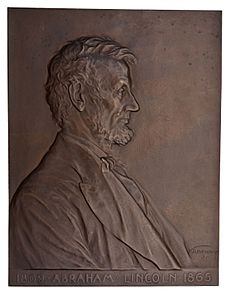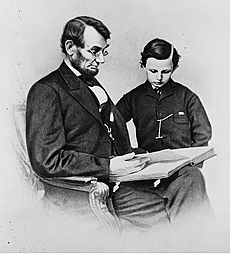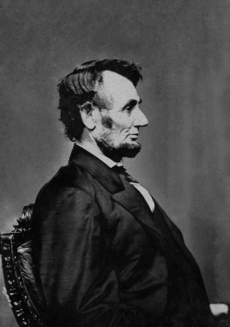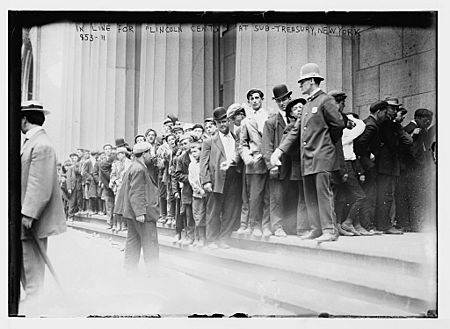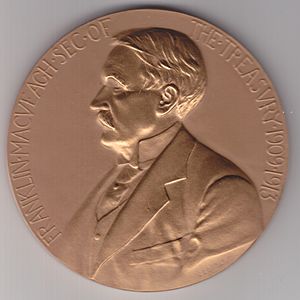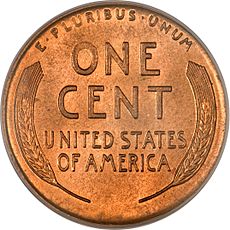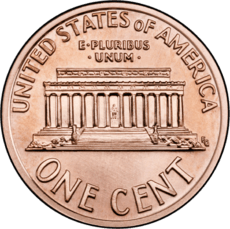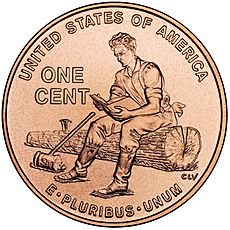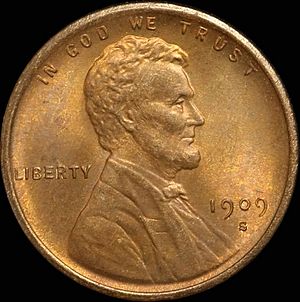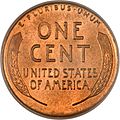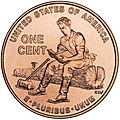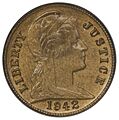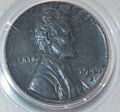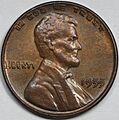Lincoln cent facts for kids
| United States | |
| Value | 1 cent (.01 US dollars) |
|---|---|
| Mass | 2.5 g (current composition). Bronze cents from 1909 to 1982 are 3.11 g; wartime steel cents are 2.7 g |
| Diameter | 19.05 mm (0.750 in) |
| Edge | Plain |
| Composition | 1909–1942, 1944–1982: 95% copper, remainder tin or zinc 1943: zinc-plated steel 1982–present: copper-plated zinc (97.5% Zn, 2.5% Cu) |
| Years of minting | 1909–present |
| Mint marks | P (2017 only), D, S, W (2019 only). Under date on obverse. No mint marks used from 1965 to 1967, in any year except 2017 at the Philadelphia Mint, or in any year except 2019 at the West Point Mint. |
| Obverse | |
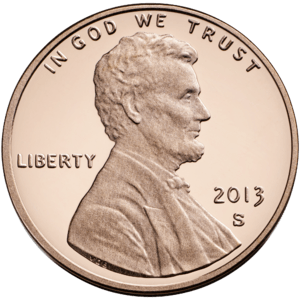 |
|
| Design | Abraham Lincoln |
| Designer | Victor D. Brenner |
| Design date | 1909 (before 1918 omitting VDB on the cutoff of the bust; modified in 2010) |
| Reverse | |
| Design | Union shield |
| Designer | Lyndall Bass |
| Design date | 2010 |
The Lincoln cent (also called the Lincoln penny) is a one-cent coin made by the United States Mint since 1909. The front side, or obverse, shows a picture of Abraham Lincoln. This design was created by Victor David Brenner.
The back side, or reverse, has changed several times. The first design, used from 1909 to 1958, showed two stalks of wheat. That's why these coins are often called "wheat pennies." The current design, created by Lyndall Bass, shows a Union shield.
All coins from the U.S. government worth one-hundredth of a dollar are called cents. The nickname "penny" comes from coins made in England.
In 1905, a famous sculptor named Augustus Saint-Gaudens was asked to redesign the cent and four gold coins. He passed away in August 1907 before he could finish the cent design.
In January 1909, the Mint hired Victor David Brenner to design a cent featuring Abraham Lincoln. This was special because 1909 was 100 years after Lincoln's birth. It was the first time a U.S. president appeared on a widely used coin. Before this, some people thought putting a person on a coin was too much like a king's portrait.
Brenner's design was approved, and the new coins were released on August 2, 1909. People were very excited to get them!
Brenner had put his initials (VDB) on the back of the coin. Many people thought they were too big. So, the Mint removed them just days after the coin came out. The initials were put back in 1918, but much smaller, on Lincoln's shoulder.
The Lincoln cent was first made mostly of copper. But in 1943, during World War II, copper was needed for the war. So, the cent was made of steel coated with zinc for one year. After the war, it went back to being mostly copper until 1982. At that time, copper became too expensive. The coin's makeup changed to mostly zinc with a thin copper layer on the outside.
The "wheat" design on the back was replaced in 1959. A new design showing the Lincoln Memorial was used to celebrate 150 years since Lincoln's birth. This design was created by Frank Gasparro. In 2009, four special designs were made to celebrate Lincoln's 200th birthday. Then, in 2010, the current Union shield design was introduced.
Contents
How the Lincoln Cent Began
In 1904, President Theodore Roosevelt thought U.S. coins weren't very artistic. He asked his Treasury Secretary if a private artist, like sculptor Augustus Saint-Gaudens, could design new coins. Roosevelt then hired Saint-Gaudens to redesign the cent and four gold coins. These coins could be changed without Congress's approval because their designs had been the same for 25 years. The Indian Head cent, which the Lincoln cent replaced, had been around since 1859.
Saint-Gaudens first thought of a flying eagle for the cent. But he learned that an eagle couldn't be on the cent by law. So, he used that idea for a gold coin instead. Saint-Gaudens was very sick with cancer in 1907. He sent Roosevelt a design for the cent showing a figure of Liberty. Roosevelt suggested adding a Native American war bonnet. But in May 1907, Roosevelt decided to use the Indian design for the gold coins instead. Saint-Gaudens died on August 3, 1907, without finishing a design for the cent.
By 1908, the gold coins were redesigned. Roosevelt then focused on the cent. The 100th anniversary of Abraham Lincoln's birth was coming in February 1909. Many people wanted a Lincoln coin. Roosevelt, who was also a Republican, wanted to honor Lincoln. This was a big change! Before the Lincoln cent, no regular U.S. coin had ever shown a real person.
In late 1908, Roosevelt met sculptor Victor David Brenner. Brenner was designing a medal for the Panama Canal. Roosevelt had liked a plaque of Lincoln that Brenner made in 1907. It's not clear how Brenner was chosen for the cent. But in January 1909, the Mint Director, Frank A. Leach, asked Brenner how much he would charge to design the coin. Brenner mentioned that the President liked his Lincoln design.
Designing the Lincoln Cent
Brenner's design for the front of the coin looks a lot like a Lincoln profile he used in other art. Some historians think he based it on an 1864 photo of Lincoln. However, Brenner also said he imagined Lincoln reading to a child. This suggests he might have been inspired by a famous photo of Lincoln with his son, Tad.
On January 18, 1909, Brenner sent his designs to the Mint. The front had Lincoln's profile. The back had a tree branch, similar to French silver coins. The Mint Director, Leach, quickly said the branch design wasn't right for the cent. He asked Brenner to create a simple design with the coin's value, the country's name, and the motto "E pluribus unum" (meaning "out of many, one").
Brenner worked fast. On February 17, he sent new designs. These were very similar to the final coin. The back showed two ears of wheat. President Roosevelt approved the designs. However, he wanted "UNITED" spelled correctly, not "VNITED" as Brenner had written. Leach also didn't like that Brenner had put his full last name on the front of the coin. Brenner agreed to move his initials to the back in small letters.
On March 4, 1909, Brenner met with the Mint Engraver, Charles E. Barber. Barber thought Brenner's designs needed changes to work for coins. Brenner felt Barber was slow to get the new coins made. He also worried that the Mint was losing details when making the large designs smaller for the coins. An outside company helped make the coin molds.
Later, the Mint was still not happy with the first test coins. They decided to add the motto "In God We Trust" to the top of the coin. On May 26, President Taft chose the version with the motto. The coin was officially approved on July 14, and the release date was set for August 2, 1909.
Releasing the New Coin
The Philadelphia Mint made 20 million of the new coins even before they were officially approved. People were very interested in the new cents. The Mint had not allowed pictures of the coin in newspapers, which made people even more curious. The Mint planned to release the coins all over the United States on August 2.
On the morning of August 2, 1909, long lines formed outside Treasury offices. Some people got all the coins they wanted at first. But soon, the coins were limited. In New York, people could get 100 coins. In Philadelphia, they could only get two. People even sold the new coins for 25 cents each outside the Philadelphia Mint! Many newsboys made money from the new coins.
Brenner's initials on the back of the coin quickly caused problems. On August 2, a newspaper asked the Treasury about the initials. Some officials said the coins might be illegal because of the initials, seeing them as advertising. On August 5, Secretary MacVeagh stopped making the cents. He wanted the coins to be made with a small "B" for Brenner, or no initials at all.
Removing the initials would cause a three-day delay. Adding a small "B" would take 14 days. So, the Mint decided to make the coins with no initials at all. Brenner was upset, but his protests didn't change anything. Cents without Brenner's initials were being made by August 12, 1909.
During this stop in production, owners of vending and slot machines complained. They said the new pennies were too thick for their machines. The Mint Engraver, Barber, was called back from his vacation. He resisted changing the coins. In the end, the machine makers changed their machines to fit the new cent instead. By the end of 1909, there were enough new cents for everyone.
Some historians believe that if Secretary MacVeagh had more experience, he wouldn't have worried so much about the initials. Other coins, like the double eagle, had prominent designer signatures.
How the Lincoln Cent Has Changed
| Back Sides of the Lincoln Cent |
|---|
The Wheat Cent (1909–1958)
Cents with and without Brenner's initials were made in Philadelphia and San Francisco in 1909. Coins from Philadelphia have no mintmark. Those from San Francisco have an "S." About 28 million Philadelphia VDB cents were made, so they are common. But the 1909-S VDB (from San Francisco with initials) is very rare. Only 484,000 were made for circulation.
In 1911, the Denver Mint started making cents with a "D" mintmark. For many years, all three mints made cents. In 1916, the design was slightly changed to make Lincoln's cheek and coat less wrinkled. This helped the coin dies last longer.
In 1917, during World War I, there was a shortage of cents. Many people still used the older Indian Head cent design. Demand for cents grew when a luxury tax was added, and people needed cents for change. In 1918, Brenner's initials were put back on the coin, near Lincoln's shoulder.
In 1922, fewer cents were made because of a recession. The Denver Mint used a worn-out die, which made the design faint. On many coins, the mintmark filled with dirt, so it doesn't appear clearly. The 1922 cent without a clear mintmark is also rare.
After 25 years, the Lincoln cent design could have been changed without Congress's approval. But people still liked the coin, so it stayed the same. In 1936, special "proof coins" were made for collectors for the first time since 1916. These were made in Philadelphia from highly polished dies.
When the U.S. entered World War II in 1941, copper and tin were scarce. The Mint tried making cents from other materials like fiber, glass, and plastic. In December 1942, Congress allowed the Mint to change the cent's material for three years. On December 23, the Treasury announced the cent would be made of zinc-coated steel.
People soon complained that the new steel coins got spotted and stained. They also confused them with dimes. Some even suggested punching a hole in the middle of the coins! The Treasury said the coins would get darker over time.
In December 1943, the Treasury announced that steel cents would stop being made after 1943. They would go back to 95% copper and 5% zinc. Some of the metal for the new coins was said to come from melted ammunition shells. After the war, the Treasury quietly removed steel cents from circulation. They didn't admit this until 1959, fearing people would hoard the coins.
A few rare 1943 bronze cents and 1944 steel cents exist today, and they are very valuable. Only one 1943-D bronze cent is known, selling for $1.7 million in 2010. There are also many fake 1943 copper cents. You can tell them apart with a magnet: steel cents are attracted to a magnet, but copper ones are not. The rare coins were likely made by accident when old coin blanks were left in the machines. The cent returned to its pre-war copper mix in 1944.
In 1952, the Mint thought about a new design for the cent. But they worried that the new Eisenhower administration might not want to replace a Republican (Lincoln) on the coin. In 1955, some cents were made with a "doubled die," meaning the date looked blurry or doubled. The Mint knew about these but released them anyway.
The Lincoln Memorial Design (1959–2008)
On December 21, 1958, President Eisenhower announced a new design for the cent's back. It would start being made on January 2, 1959. The new design, by Frank Gasparro, showed the Lincoln Memorial in Washington, D.C. This change was a complete surprise! The coin was officially released on February 12, 1959, Lincoln's 150th birthday.
Gasparro created the design without ever visiting the Lincoln Memorial in person. Some people thought the design looked like a "trolley car."
In 1960, there was excitement over "small date" and "large date" cents. The small date coins were rarer. The Mint enlarged the date to prevent the "0" from breaking during coining. Bags of 1960 small date cents sold for thousands of dollars. Prices went up until 1964 when the excitement ended.
In 1964, the price of silver went up, and people started hoarding silver coins. This led to a shortage of change, and people even started hoarding cents. The Mint Director, Eva Adams, thought collectors were taking coins from circulation. So, she ordered that mintmarks no longer appear on coins. Coins continued to be dated 1964 until the end of 1965.
The San Francisco Mint, which had stopped making cents after 1955, started again. But these coins also had no mintmarks. In 1968, mintmarks were put back on the cent. San Francisco started making a limited number of cents for circulation and also started making proof coins. Lincoln's features on the coin became clearer in 1969 when a new master mold was used.
Copper prices rose again in 1973. The value of the copper in a cent was almost one cent. People started hoarding cents, hoping to make a profit. The Mint decided to switch to an aluminum cent. Over 1.5 million aluminum cents were made in late 1973, dated 1974. But vending machine companies said aluminum cents would jam their machines. So, the Mint stopped the idea.
The Mint Director, Mary Brooks, asked for the aluminum cents that had been given to members of Congress to be returned. But 14 of them went missing. One aluminum cent was given to the Smithsonian Institution. Experiments were also done with bronze-coated steel cents. A few of these were kept by workers when a bag of them broke open.
In 1981, copper prices rose again. The Mint decided to change the cent's makeup to copper-covered zinc. The first of these new cents were made on January 7, 1982. A few rare 1983 cents were made by mistake in bronze. Small changes were made to Lincoln's portrait in the 1990s and early 2000s.
Lincoln Bicentennial Cents (2009)
A law passed in 2005 required the cent's back to be redesigned for 2009. Four new designs were made to celebrate Abraham Lincoln's 200th birthday. These coins showed different parts of Lincoln's life: his early life in Kentucky and Indiana, his work life in Illinois, and his time as president. The designs were shown on September 22, 2008, at the Lincoln Memorial.
- Birth and early childhood in Kentucky: This design shows a log cabin. It was released on Lincoln's 200th birthday, February 12, 2009.
- Formative years in Indiana: This design shows a young Lincoln reading while taking a break from splitting rails (logs). It was released on May 14, 2009.
- Professional life in Illinois: This design shows Lincoln as a young lawyer in front of the Illinois State Capitol. It was released on August 13, 2009.
- Presidency in Washington, D.C.: This design shows the partly finished Capitol dome. This fourth cent was released on November 12, 2009.
The law also said that special collector's sets, made with the same metal mix as the 1909 cents, should be sold.
The Union Shield Reverse "Shield Cent" (Introduced 2010)
The law also required that the cent, starting in 2010, show something that represents Lincoln keeping the United States united. In April 2009, a committee suggested a design with 13 wheat sheaves tied together. But this design was later removed because it looked like coins from Germany. Another committee suggested a Union shield with "ONE CENT" on it.
In June 2009, another committee chose a design with a modern American flag. But on November 12, 2009, the Union shield design was announced as the winner for the 2010 cent. The Mint says the 13 stripes on the shield show the states joined together to support the government.
The new back design was created by artist Lyndall Bass and sculpted by Joseph Menna from the U.S. Mint. The Mint also improved the front of the coin, making Lincoln's portrait clearer.
In January 2017, cents with the current date and a "P" mintmark from the Philadelphia Mint appeared. The Mint confirmed these were real. They added the mintmark to honor the Mint's 225th anniversary. All cents made in Philadelphia in 2017 had the "P" mintmark, but later years did not.
In February 2019, the Mint announced that the West Point Mint would make cents with a "W" mintmark. These are not for everyday use. They are special coins made for collector sets.
A law signed in 2021 allows for special one-year designs for coins in 2026. This will celebrate the 250th anniversary of the United States. One of these designs will feature women.
Images for kids
-
Proof-quality Lincoln penny with cameo effect, obverse.
-
1909 VDB "US Lincoln Penny" – on the planet Mars – part of a calibration target on the Curiosity rover (September 10, 2012).
See also
 In Spanish: Centavo Lincoln para niños
In Spanish: Centavo Lincoln para niños



